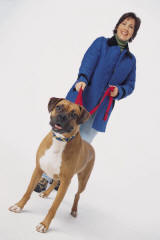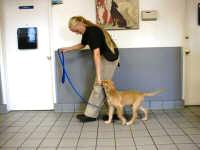
Click on
Library Icon
to learn more
|
Easy
does it
One of the great
satisfactions of having a dog is enjoying the
companionship on walks. However, if the dog walks
you instead of you walking the dog, the result may
be frustration for you both!
Rules for
the road
First, NEVER allow your
dog to pull or tug on the leash. As soon as the
leash is no
longer loose, STOP in your tracks. Do not continue
the walk until the dog returns some slack to the lead. Initially, this approach takes
patience and does not make for a very good walk.
But, in the long run, you will reap the rewards of a
dog that does not turn the walk into a game of
tug-of-war!
slack to the lead. Initially, this approach takes
patience and does not make for a very good walk.
But, in the long run, you will reap the rewards of a
dog that does not turn the walk into a game of
tug-of-war!
Pulling on the leash is unsafe for the dog as well
as unpleasant
for the walker. If lunging occurs it can
frighten other people and dogs who pass by. If the
dog only pulls on occasion, one option is to teach
the word, "Easy,"
to mean, stop pulling on the
leash. The way this is taught initially is to first
say the word, "easy" and then simply turn and walk
in a different direction. If the dog begins to pull
in that direction, repeat. Keep turning until
the dog is confused about the direction you are
going. You can also say "Easy,"
and then stop walking. The dog
learns that no forward progress happens when he or
she is pulling on the leash. A head collar/halter is
helpful in teaching leash-walking rules, especially
for dogs that are particularly boisterous.
|
You want the dog to realize
that it is in the dog's best
interest to keep a loose
leash because a tight leash
means the walk stops. |
As
soon as there is any amount of
slack in the lead, praise the
dog.
B egin to walk again
and continue to praise him or
her as long as there is slack in
the lead - which means the dog
is not pulling on the leash. As
you praise the dog, gradually
let longer and longer periods go
by between the praise. If he or
she begins to pull again, then
simply give the Instruction,
"Easy"
as a reminder. Soon the dog
should understand that "easy"
means to ease-up on the lead.
You want the dog to realize that
it is in the dog's best interest
to keep a loose leash. egin to walk again
and continue to praise him or
her as long as there is slack in
the lead - which means the dog
is not pulling on the leash. As
you praise the dog, gradually
let longer and longer periods go
by between the praise. If he or
she begins to pull again, then
simply give the Instruction,
"Easy"
as a reminder. Soon the dog
should understand that "easy"
means to ease-up on the lead.
You want the dog to realize that
it is in the dog's best interest
to keep a loose leash.
|